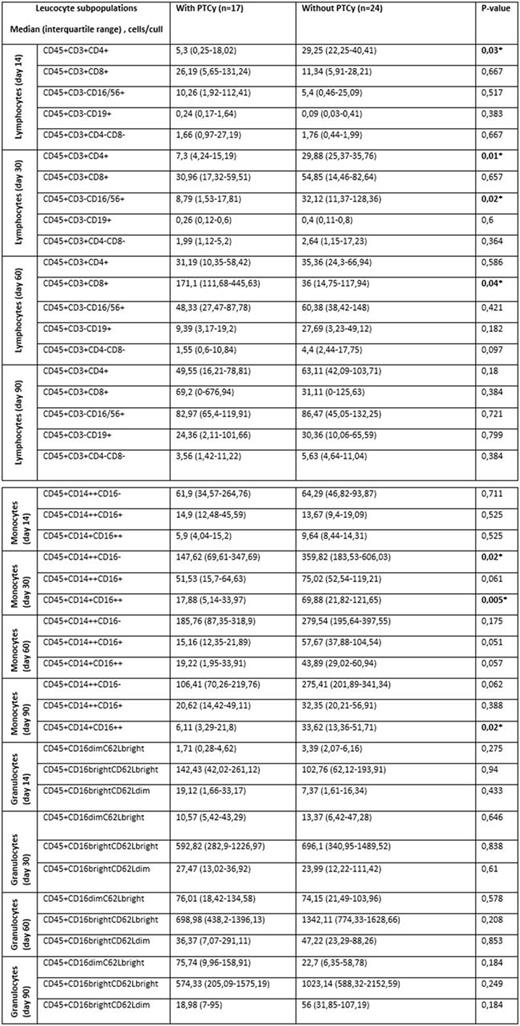Abstract
Introduction: Hematopoetic stem cell transplantation (HSCT) is the only curative therapy for many patients with hematologic malignancies. Occurrence of complications and mortality after allo HSCT is still high and it's strongly associated with immune reconstitution. Despite the wide-spread of Post-Transplant High-Dose Cyclophosphamide (PTCy) immune reconstitution and immunological safety of this method is still poorly understood.
Aim: to evaluate immune reconstitution profile in patients who was underwent HSCT with a bone marrow as a stem cell source and with or without PTCy.
Patients and methods: In National Research Center for Hematology 41patients after allogeneic HSCT were analyzed in 2 groups; patients with PTCy (n=17) and without PTCy (n=24). The total cohort had 12 males and 29 females, and had a median age of 33 years (range 19-61). All patients were diagnosed with a hematological malignancy. 14 patients were underwent myeloablative conditioning and 27 patients - non-myeloalative prior HSCT.
The GVHD prophylaxis consisted of ATG-PTCy-CsA-MMF (n=10), ATG-PTCy (n=5), Mono-PTCy (n=1), ATG-CsA-MMF-MTX (n=20), CsA-MTX (n=2), ATG-CsA-MTX (n=2), CsA-MMF-MTX(n=1). The patients who only had received ATG were included on the analysis.
Immune reconstitution profile was tested via serial flow cytometry analysis of peripheral blood on day +14, +30, +60 and +90 after allo-HSCT. Anti-CD3 FITC, anti-CD16PE, anti-CD56 PE, anti-CD45 Per-CP-CYTM5.5, anti-CD4 PE-CyTM7, anti-CD19 APC, anti-CD8 APC-Cy7; anti-CD62L FITC (BD Biosciences, USA); anti-CD14PE, anti-CD16PE, anti-HLA-DR APC (eBiosciences, USA) were used to define white blood cell subsets.
Results: Reported detailed data is presented in Table 1. In bone marrow recipients the number of CD4+- cells was significantly lower on day +14 and +30, NK-cells on day +30 and CD8+-cells on day +60 in case of using PTCy versus immunosuppression without PTCy.
The number of classical monocytes on day +30 and patrol monocytes on day +30 and +90 was significantly lower in case of using PTCy versus a standard protocol.
Conclusion:
Lymphocyte and monocyte reconstitution was impaired for the PTCy groups in the immediate post-HSCT period but quickly recovered. The mechanism of tolerance induction with PTCy on day+ 3, + 4 is not limited only to deletion of alloreactive T-cell clones, but also affects other leukocyte subpopulations (B cells, monocytes, granulocytes). The use of PTCy on day+ 3, + 4 is an immunologically safe method for prevention of GVHD.
Table 1. Short-term reconstitution in BM recipients with and without PTCy
No relevant conflicts of interest to declare.
Author notes
Asterisk with author names denotes non-ASH members.


This feature is available to Subscribers Only
Sign In or Create an Account Close Modal